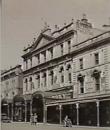Located on one side of the Victoria Arcade in Bourke Street between Swanston and Russell streets, the Gaiety was effectively a companion venue to the second Bijou Theatre, which occupied the other side of the arcade. In this respect both theatres used the Arcade as a vestibule. A small purpose-built vaudeville theatre, the Gaiety stood on the site previously occupied by the Palace Hotel, and which also operated a hall for community and social events during the first Bijou era. Both buildings were built and opened in 1890 following the fire which destroyed all three landmarks the previous year.
While the Gaiety long played second fiddle to the more sumptuous Bijou, it was nevertheless historically significant in terms of providing a space for variety entertainment in Melbourne. In the early 1890s it was associated with Dan Tracey, and a little over ten years later with fellow-American minstrel and vaudeville entrepreneur F. M. Clark. A year or so after Clarke departed James Brennan took it over, basing his Melbourne operations there until he built his own amphitheatre in 1912. The following year the Fullers took over the lease of both the Bijou and the Gaiety, and in 1915 bought the freehold of both theatres and the Victoria Arcade for £150,000.
As with the Bijou the Gaiety continued to operate up until the early 1930s, although it was renamed The Roxy in 1930. Four years later both theatres were demolished and the site remained vacant until 1939 when the Gaiety portion of the property became the Commonwealth Bank building. The entire property remained one of Sir Benjamin Fullers assets right though until his death.
[Source:
Australian Variety Theatre Archive]

